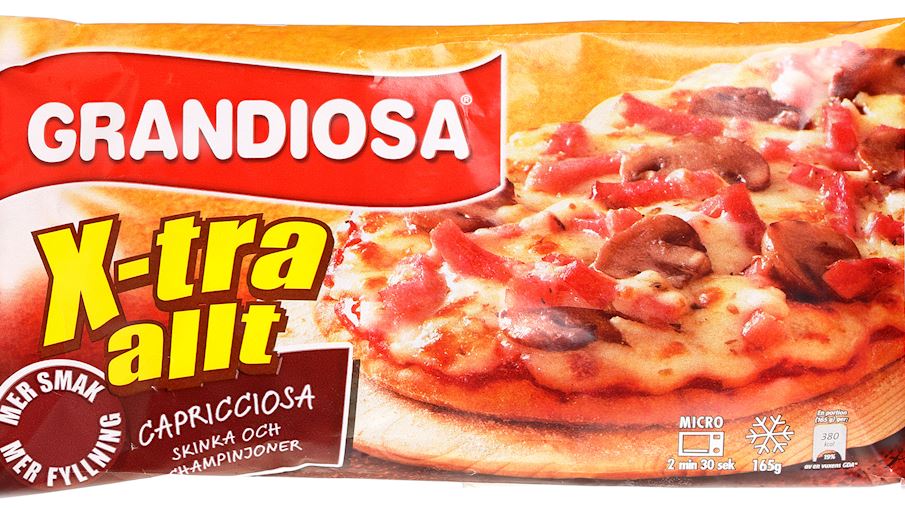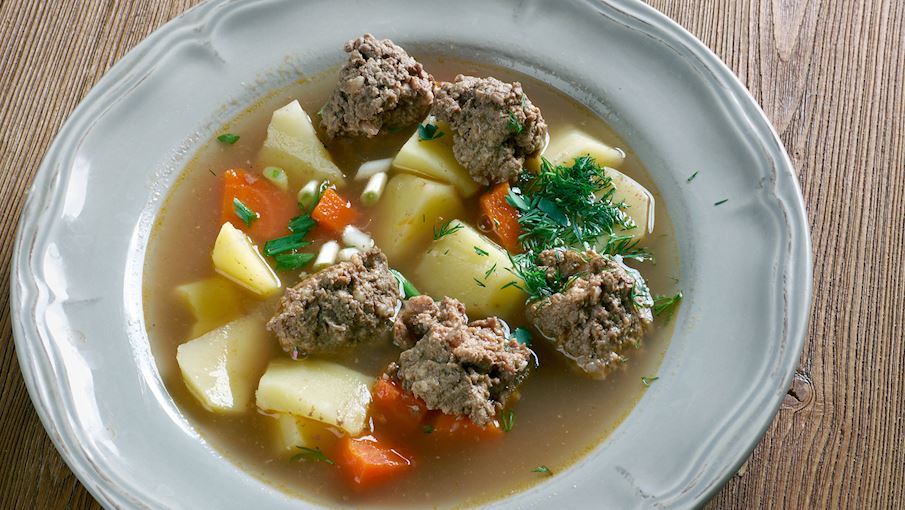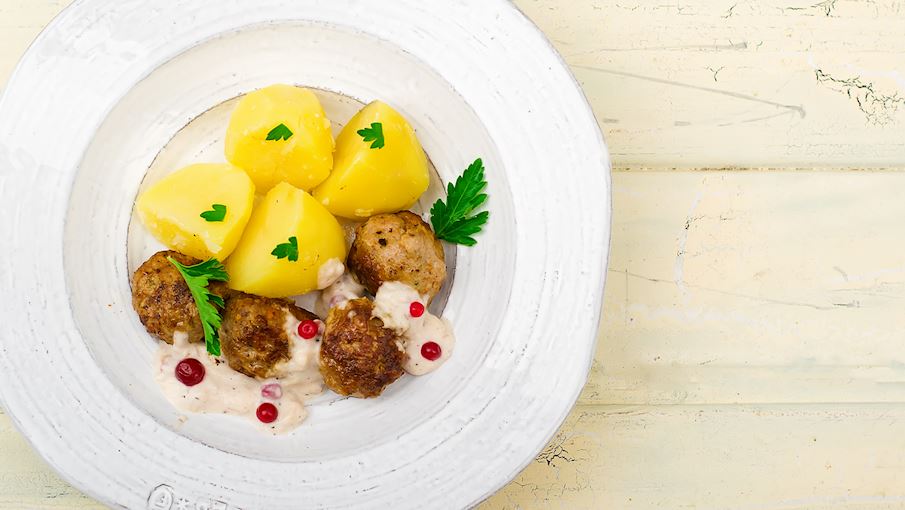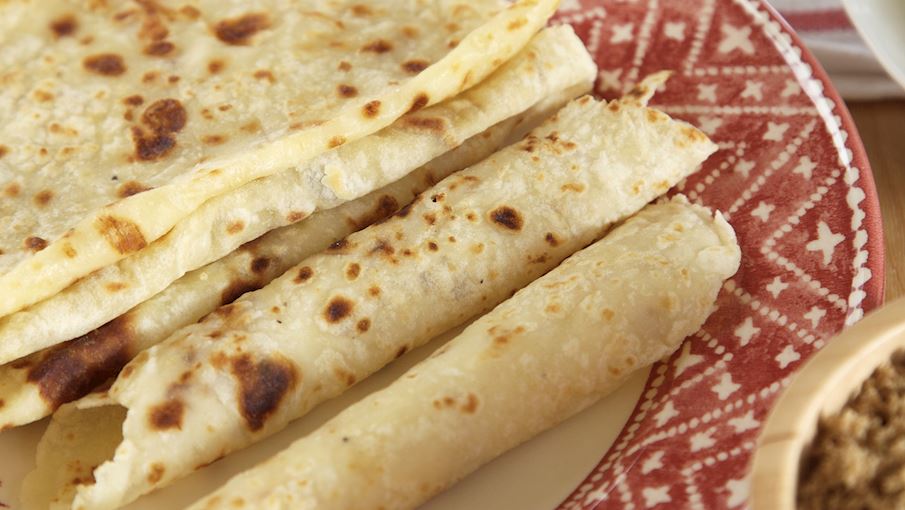Skillingsboller

Skillingsboller is a traditional Norwegian version of a cinnamon roll. This circular pastry is usually associated with Bergen. The rolls are made with a combination of flour, milk, yeast, eggs, sugar, cardamom, lots of butter, and chopped almonds (optional).
After the baking, skillingsbolle are brushed with additional butter on the top and the bottom while they are still hot. The top is also sprinkled with extra sugar and cinnamon. The name skillingsboller means penny bun. They’re usually eaten as an afternoon snack with a cup of coffee on the side, but some people like to eat them with brown cheese (Brunost).
Kransekake

Kransekake is a traditional Nordic dessert consisting of a number of concentric cake rings which are usually shaped into a large cone or a tower. The crispy cakes are made with ground almonds, sugar, and egg whites, and are held together with a white icing glaze.
Even though little is known about the origin of this luxurious cake, it is usually associated with various festive occasions in Norway, Denmark, Sweden, and Finland. Depending on the event, the cake might come in different sizes, and the center is often filled with candies, chocolates, and even champagne or wine bottles.
Fårikål

The national dish of Norway, fårikål, is hearty mutton and cabbage stew, typically served with boiled potatoes. The list of ingredients is scarce: only mutton, cabbage, salt, pepper, and water, although some recipes call for the broth to be thickened with flour.
Traditionally, this stew was a seasonal, autumn dish, but today it is eaten throughout the year.
Pizza Grandiosa

Norwegian Grandiosa—whose name is derived from the Italian word for big or great—is the first frozen pizza ever produced in Norway. When it first appeared in 1980, the choice of toppings in Grandiosa Original included tomato sauce, pizza meat, Jarlsberg cheese, and peppers, but the company soon expanded the basic flavor range with classics like Grandiosa Pepperoni, Grandiosa Kjøttdeig & Løk (beef mince and onions) and Grandiosa Helmax (ham and salami), whereas now you can even indulge in Grandiosa Hot Nacho and Grandiosa Kebab pizza.
It wasn’t until the 1990s that the sales began to pick up, but by the 2000s, Grandiosa was being exported to five neighboring countries and established as Norway’s best-selling frozen pizza. Today, Norwegians are divided about their boxed food icon: while some consider it the country’s national dish, others refer to it as “laziness in a box.”
Sodd

Satisfying sodd is Norway’s national dish which usually consists of diced mutton, meatballs (made with beef, lamb or mutton), carrots, and potatoes served in a clear, fragrant broth. The vegetables are usually cooked separately and are then added to the broth.
The soup has been a staple in Norwegian cuisine since the 13th century, and today it is mainly associated with the Trøndelag region. Sodd is usually served on special and festive occasions and it is traditionally paired with Norwegian flatbread on the side.
Fiskesuppe

Fiskesuppe is a popular Norwegian fish soup characterized by its creamy texture and buttery flavor. This comforting dish appears in many regional and seasonal versions, but it usually consists of various types of fish, shellfish, and root vegetables, cooked in a rich broth with butter, milk, and cream.
Even though it is native to Norwegian coastal areas, this hearty, chowder-like soup is considered to be a national specialty which is prepared and consumed throughout the country. Before serving, it is seasoned with a variety of fresh herbs and a drizzle of tangy lemon juice.
Fiskesuppe is enjoyed as an appetizer and is usually accompanied with crispy slices of buttered bread.
Kjøttboller

Kjøttboller or kjøttkaker are traditional Norwegian meatballs. Even though they share many similarities to their Swedish counterpart, they are usually larger in size and more often shaped as meat patties or meat cakes.
Among the numerous varieties, traditional versions mainly employ minced beef that is generously seasoned with nutmeg and ginger, and occasionally combined with eggs, onions, oats, and cornstarch. Norwegians prefer to pan-fry the meatballs and enjoy them as a main course, accompanied by a creamy sauce or a thick gravy.
Boiled or mashed potatoes, mashed peas, lingonberry jam, creamed cabbage, or caramelized onions are the most common sides served with this hearty and satisfying meal.
Pinnekjøtt

Pinnekjøtt is a traditional Norwegian Christmas dish predominantly enjoyed in the northern and western parts of the country. It is usually prepared with racks of lamb or mutton, which are brined and air-dried or smoked before they are sliced into individual ribs and cooked.
Traditionally, the ribs are placed on birch branches and steamed until all the water evaporates and the meat becomes juicy and tender. This flavorful Norwegian classic stems from the traditional methods of meat preservation and is usually complemented with mashed or boiled potatoes, pureed Swedish turnip, and various salads.
Lefse

Lefse is a traditional Norwegian flatbread, visually looking like a huge, round tortilla. It comes in many varieties such as plain, sweet, thin, or thick. There is also a popular version of lefse with potatoes incorporated in the dough, and it is a favorite of the Telemark region.
Originally, potatoes were not included in the flatbread since potatoes were introduced to Norway just about 250 years ago. Today, lefse is usually dipped into a bowl of water to absorb it, and is then consumed with butter, cinnamon, and sugar. For serving, it is recommended to roll the flatbread and cut it at an angle.
All of the lefse varieties can also be used to make appetizers or sandwiches, when they are filled with cheese, salad, seafood, or meat. Potato lefse is especially good for canapés due to its unique flavor. In Norway, lefse can be bought at most supermarkets or baked at home, and it is also popular in the United States of America, in cities with high percentages of Norwegian ancestors such as Minnesota, North Dakota, and Seattle.
Lutefisk

Lutefisk is a Scandinavian dish made from dried whitefish that’s been treated with lye, resulting in the fish having a gelatinous consistency and often, depending on the type of whitefish, a very strong, pungent odor. Both the Swedes and the Norwegians claim the dish as their own, but lutefisk is also prepared in Finland and in the United States, namely in the state of Minnesota, where it’s predominantly consumed by Scandinavian immigrants.
After it’s been cooked, the lye-treated fish is served with an array of side dishes. In Norway, it is typically served with boiled potatoes, mashed green peas, melted butter, and pieces of fried bacon, whereas a side of white sauce in combination with previously mentioned boiled potatoes and green peas is the traditional choice of Swedes and Finns.
Source: tasteatlas.com


